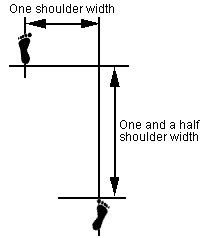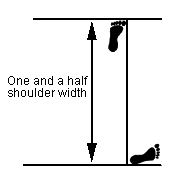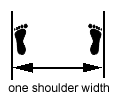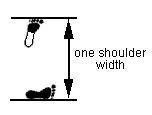.gif)
Stances (tae kwon do)
Encyclopedia
The Korea
n martial art Taekwondo
has several stances used for different activities.
Korea
Korea ) is an East Asian geographic region that is currently divided into two separate sovereign states — North Korea and South Korea. Located on the Korean Peninsula, Korea is bordered by the People's Republic of China to the northwest, Russia to the northeast, and is separated from Japan to the...
n martial art Taekwondo
Taekwondo
Taekwondo is a Korean martial art and the national sport of South Korea. In Korean, tae means "to strike or break with foot"; kwon means "to strike or break with fist"; and do means "way", "method", or "path"...
has several stances used for different activities.
Basic stances
Although there are strong similarities in stances throughout Taekwondo schools, individual instructors often have their own preferred style. For example, in the Charyot stance, feet are often at 45 degrees, keeping eyes forward while bowing. However, many instructors prefer the feet parallel forward, with the eyes facing toward the floor while bowing (as a sign of respect and trust for those around them).| Diagram | Name | Description |
|---|---|---|
 |
Attention Stance Also known as:
|
This is the attention position used before and after class. The feet are at 45 degrees. However, recent Kukkiwon changes now require feet to be touching and pointing forward, particularly in WTF recognized sporting events. Failure to do so results in point deduction. When bowing you bend 40 degrees forward, keeping your eyes averted from your opponent, as looking straight on denotes disrespect. |
 |
Closed Stance
Also known as:
|
This can be either full facing or side facing. There are four varieties, Moa Junbi Sogi A, Moa Junbi Sogi B, Moa Junbi Sogi C and Moa Junbi Sogi D. |
 |
Walking Stance
Also known as:
|
Walking stance is used when mobility is important. It is also a precursor of the fighting stance according to some authors. Body should be relaxed. From the attention stance with feet together, one foot is placed straight ahead of the other, about a normal walking step. Some style teaches to step side way slightly. The distance between both heels is about a shoulder length to one-half shoulder length. Rear toes are turned outward about 30 degrees. The weight should be 50-50. In International Taekwon-Do Federation, this stance's length is measured from the tip of the big toe to the tip of the big toe.
There is a variant of this stance called Nachuo Sogi or Low Stance which is One foot length longer. The stance can be either Full, Half or Reverse half facing. There is also a short stance "Ap Sogi" that is half-length of this stance. |
 |
L Stance Also known as:
|
This stance is specifically focused on shifting weight to the back leg, as it offers much more control, and makes it easier to kick off the front leg. To perform this stance, the body faces to the side, with the front foot facing forwards, front leg bent. The back leg is bent slightly, and the foot is turned outwards perpendicular to the front foot. When learning this stance, it is helpful to use a mirror. Align your feet as stated above - some styles require that your body is turned so only your front shoulder is visible through the mirror. Since there is virtually no weight on that front leg, it can be swept without affecting the practitioner's overall balance. The weight distribution of this stance is 30%-70%. Both legs should be slightly bent, the back foot or the foot with the most weight on it should be bent in slightly. the back knee should be over the foot.
There is a variant of this stance called Gojung Sogi or Fixed Stance which is One foot length longer, the weight distribution is 50-50, So when performing this stance you should just be able to see the toes of you back foot over your knee. All techniques in L-Stance can only be half facing. |
 |
Parallel Ready Stance Also known as:
|
Ready Stance refers to the most common ready position use Tae Kwon Do training. Ready Stance is performed by standing with the feet one shoulder length apart, measured from the outside edge (Foot Sword) of the feet, with arms slightly bent and loosely held fists about one fist size apart just below the navel and the fists should be a fist size away from the body. Muscles are relaxed to promote movement speed from this position. This stance and its variants are most often used at the start of patterns. The student should be alert and aware, inhale and breathe out 1/3 of the air in your lungs. |
 |
Rear Foot Stance
Also known as:
|
Stand with your front foot facing forwards and the back foot turned 45 degrees to the side, keep the feet quite close together. Shift most of your weight to your back foot, so the front foot is only for balance and you can kick from it with little body weight shifted. Additionally, your front foot should be up on the ball of the foot (heel off the ground). This stance appears in Taeguek Chil-Jang, Taegeuk Pal-Jang, and Joong-Gun. |
 |
Sitting Stance
Also known as:
|
The sitting stance is generally used to practice punches. It is similar to the ready stance. Feet are placed much wider, about two-shoulder length's apart. Also, the knees are deeply bent. The shins should be kept perpendicular to the floor. This requires the knees to move outwards away from the body. The hands are held in fists, on the hips at belt level, with the thumbs up. When a punch is thrown, the hand rotates 180 degrees to turn knuckles up before making contact. In combat it is used when being grappled in order to have a wide stance and low center of gravity, giving stability (compare with Judo and wrestling defensive stances). Short range punches can be used on the target who is holding one around the waist. Some examples are: the last movement in Taeguek 7 - a side punch in Juchum Seogi, and stepping forward in diagonal in Juchum Seogi and punching in Hoshinsul technique. This stance can be used instead of a L-stance to perform a sidekick. The weight distribution of this stance is 50%-50% and should be directed inwards.
This stance can also be used as a stretch. The object is typically to keep the back straight while lowering the buttocks down to the ground with the legs spread keeping shins perpendicular to the floor. The ultimate goal is to maintain this posture while the tips of the belt touch the ground. |

